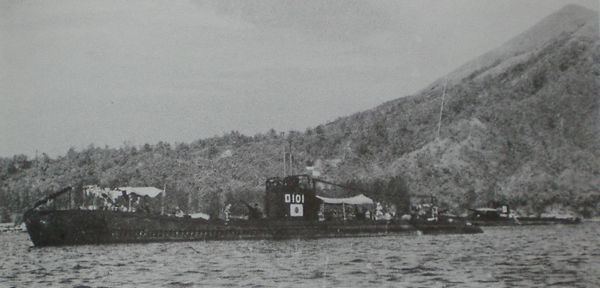Name Ro-100-class submarine Built 1941–44 Planned 18 | In commission 1942–45 | |
 | ||
Builders Kure Naval ArsenalKawasaki Shipbuilding | ||
The Ro-100-class submarine (呂百型潜水艦, Ro-hyaku-gata Sensuikan) was a group of medium-sized coastal submarines built for the Imperial Japanese Navy (IJN) during World War II. The IJN official designation for this class was Ko Type submarine (小型潜水艦, Ko-gata sensuikan, "Small Type Submarine") or Senshō Type submarine (潜小型潜水艦, Sen-Shō-gata sensuikan, "Submarine-Small Type"). The type name, was shortened to Sensuikan Ko-gata (潜水艦小型, Submarine-Small Type).
Contents
Design and description
In 1940, the IJN designed a point-defence coastal submarine because they wanted to save their larger submarines for fleet battles. The Ro-100 class was derived from the preceding Kaichū type. They displaced 611 tonnes (601 long tons) surfaced and 795 tonnes (782 long tons) submerged. The submarines were 60.9 meters (199 ft 10 in) long, had a beam of 6 meters (19 ft 8 in) and a draft of 3.51 meters (11 ft 6 in). They had a double hull and a diving depth of 75 meters (246 ft).
For surface running, the boats were powered by two 500-brake-horsepower (373 kW) diesel engines, each driving one propeller shaft. When submerged each propeller was driven by a 380-horsepower (283 kW) electric motor. They could reach 14.2 knots (26.3 km/h; 16.3 mph) on the surface and 8 knots (15 km/h; 9.2 mph) underwater. On the surface, the Ro-100s had a range of 3,500 nautical miles (6,500 km; 4,000 mi) at 12 knots (22 km/h; 14 mph); submerged, they had a range of 60 nmi (110 km; 69 mi) at 3 knots (5.6 km/h; 3.5 mph).
The boats were armed with four internal bow 53.3 cm (21.0 in) torpedo tubes and carried a total of eight torpedoes. They were also armed with two single mounts for 25 mm (1 in) Type 96 anti-aircraft guns or a single 76 mm (3 in) AA gun.
Boats
18 boats were built in 1941-1944 under the Maru Rin Programme (Boat #210-218) and the Maru Kyū Programme (Boat #400-408).
